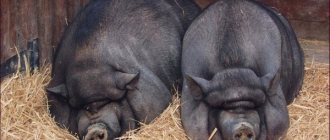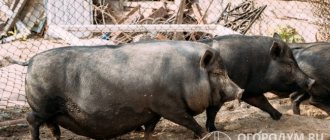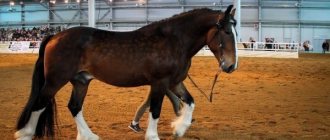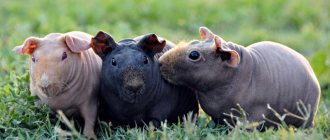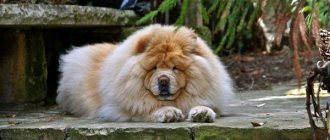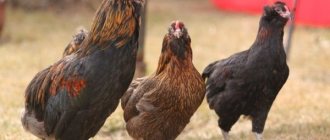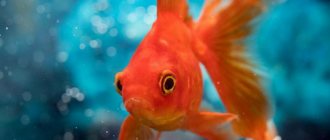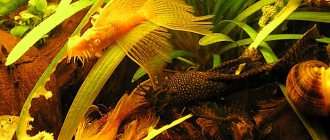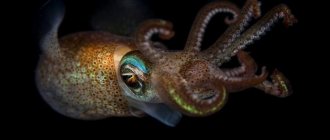Breeding pigs for meat and bacon production is extremely popular among modern livestock farmers. Today we will talk about Duroc pigs, which are deservedly considered one of the most prominent representatives of this type.
Duroc pigs (pictured) are prominent representatives of farm animals for meat production.
Breed characteristics
If we describe the Duroc pig breed, the characteristics of external characteristics will be as follows:
- impressive size of individuals (males are 180-185 cm long, females are slightly smaller);
- short thick legs and hams;
- rounded back with a slight arch;
- ears are large, hanging forward;
- The color of the skin ranges from golden to crimson-red, lighter tan marks are allowed, but white spots are considered a defect.
The live weight of a male Duroc breed can exceed 3.5 centners, the weight of a pig reaches 3 centners. The layer of fat in the back area is quite thin - 1.5-1.8 cm. At the output, the breed produces 60-70% meat in its pure form. The product is of very high quality.
Large white pig
Brought from England, it is considered an older and more widespread breed.
The popularity of the breed in our country is associated with its versatility - animals can be successfully fattened to fatty conditions, producing bacon or high-quality meat. As a result of the breeding work carried out, it was possible to strengthen the constitution of the large white pig and change the type of breed in the meat and fat direction. Animals of this breed are large
- The head is moderate in size with a wide forehead and a medium-length snout.
- The ganaches are meaty, dense and widely spaced.
- Ears are elastic, directed upward, forward and to the sides
- The neck is short, muscular, and smoothly blends into the body.
- The shoulders are wide and fleshy.
- The withers are wide and straight, without depressions behind the shoulder blades.
- The legs are dry, well muscled, the hooves are strong.
- The chest is wide and deep.
- The back is wide, straight or slightly curved upward (arched), imperceptibly passing into the chest and sacrum.
- The belly is voluminous, but not saggy, dense.
- The sacrum is wide, fleshy
- The hams are wide, round, fleshy and without sharp interceptions, descending to the hock joint.
- The skin is soft, elastic, without folds at the joints, evenly covered with light bristles.
- The color of pigs is white.
Large white pigs are characterized by high early maturity; at one year of age, under good feeding and maintenance conditions, they weigh 180-210 kg, and sometimes more. The live weight of adult boars is 280-370, sows - 200-270 kg. The fertility of adult sows is 11-12, and sometimes 14 or more piglets per litter, their milk yield reaches 70-90 kg. Slaughter yield is 82%. Animals of this breed, when well fed, produce meat of very high quality. If you cut a piece of meat from a fattened pig across the muscle fibers, you will see that it is all evenly sprouted with thin layers of fat and has the appearance of marble, which is why it is often called “marbled.” This meat is very juicy, tender, tasty and is in great demand among consumers. Some disadvantage of the large white breed, as well as other white breeds, especially for the south of Ukraine, is their white color, as a result of which the animals suffer from sunlight.
Meat breed Duroc
The meatiest pig breed is the Duroc. An adult animal can reach 250 kilograms of live weight. The thickness of the lard is only 3 centimeters.
This breed is distinguished by its large size. After all, a male individual can reach almost two meters (1.8). As for the females, they are slightly smaller in size. In general, meat breeds are distinguished by an elongated body, but in this case everything is different. The Duroc carcass is wide and massive, the back is convex, and their head is small in size, with sharp ears either sticking up or extended forward.
Another difference between this breed is its color; they have many shades: golden, dark brown, brown. Medium length bristles to match skin color. Pigs gain weight rapidly, so the older the pig, the less active it is.
Productivity Duroc
If you have decided to raise pigs, then you need to know how you can get a large yield of meat and lard at minimal cost. It was said above that the meat yield from one carcass is 80%, but this happens if the animal is well fed. To get such a good result, the animal must receive a lot of protein food.
Research has shown that the quality and quantity of pork meat is also affected by the conditions in which the animal is kept. It is necessary to ventilate the visit, constantly clean it, and the pen must always be clean and dry. In winter, it must be insulated, and there should never be any extraneous noise or irritants there.
Advantages and disadvantages of the breed
The advantages of the Duroc breed include:
- rapid growth and the same weight gain;
- endurance and adaptability to any conditions;
- obtaining a large amount of tasty and juicy meat;
- There is almost no subcutaneous fat;
- calm character: they do not fight, do not bite, and are also careful with their piglets.
The Duroc breed is an excellent option for keeping and breeding meat pigs. But even such an “ideal” breed has its drawbacks:
- at one time a pig can bring no more than 10 piglets, but on the other hand this is good, because the fewer piglets in the belly, the greater their survival rate;
- susceptibility to respiratory diseases;
- Weight gain will directly depend on the amount of protein consumed.
Pig care
Fortunately, this breed is not fussy to keep; during the warm season, they can be kept in open pens where there is enough space. Animals must be fed three times a day in winter and twice a day in summer.
It is important to ensure that animals receive enough protein. It is impossible for the room to remain unventilated, dirty, and the presence of drafts is also unacceptable, since pigs are prone to diseases
Breeding the Duroc breed
As farmers say, it is not profitable to keep Duroc pigs for offspring and meat production, since consumption exceeds productivity. After all, a sow of another breed brings more than 30 piglets at a time, when Duroc can bring a maximum of 20 piglets.
Active heat in sows lasts two days, during which time it is best to leave her completely alone. The next day it is done with a wild boar, twice to get 100% results. The survival rate of newborn piglets is 93%.
Feeding
When feeding piglets, their increased demands for protein foods should be taken into account. Animals that have reached two months of age are selected for fattening.
The goal is to achieve a 100-kilogram live weight. This result is achieved in the shortest possible time if the feeding regime is followed and the feed is well balanced.
Food for the Duroc breed can consist of combined silage, potatoes, legumes, and cake. Cereals can be used for nutrition. For fattening piglets, it is beneficial to include in the diet:
- beets (fodder and sugar varieties);
- bone and fish meal;
- meat and fish waste;
- milk and dairy products;
- return
Piglets need to be given hard grains to develop teeth. They are accustomed to solid food from the fifth day of life. Feeding is needed even when piglets have enough mother's milk. Additional foods are important for the prevention of rickets.
Fattening begins at 2 months of age. Animals need a combination feed, presented by:
- potatoes;
- combined silo;
- cake;
- peas;
- reverse;
- bone and fish meal.
The presence of large amounts of corn, oats and barley in the feed can cause obesity and loss of meat quality in pigs.
In summer, feeding is carried out twice a day. In winter, an additional third feeding is introduced.
What to feed pigs?
With an optimal feeding regime and high quality feed, the average daily weight gain of Duroc pigs can reach approximately 900 g with the accumulation of a good layer of fat (up to 18 mm). At the same time, feed costs are considered relatively low (about 3.75 feed units). The yield of meat from the carcass is also high, on average - about 65%. Since the Duroc was bred primarily as a meat breed, in order to increase muscle mass, the diet of pigs must have a slightly higher protein content compared to pure bacon breeds. Feeds rich in carbohydrates (cereals, soybeans, corn) should be presented in minimal quantities.
It is recommended to introduce an adult diet from the age of three months. If animals are being fed for slaughter, then about a month before it, when the piglets reach a weight of about 100 kg, it is recommended to give potatoes more often, but in no case raw.
An approximate diet for growing piglets can be presented as follows. Meat (fish, dairy products or any protein concentrate) should be up to 200 g per day per kilogram of animal weight. Also, growing piglets need to add salt to the feed, at least 14 g per kilogram of weight. Calcium must be added to the feed; it is required for skeletal growth. The simplest solution to the problem of its shortage may be ordinary chalk. Already when the weight of young animals is about 20 kg, it is necessary to add potatoes and succulent feed to the diet.
As the animal grows, the amount of salt should also increase. You will have to give more plant foods. The amount of food also increases. If a 10-day-old pig requires 50 g of food, then a month-old animal should receive at least 250 g per day, and a two-month-old pig will need about 900 g of food.
Drinking water should always be available to pigs. If piglets need no more than 5 liters per day, then adults may not need even 15 liters. Pregnant and lactating sows need even more water (up to 25 liters per day).
A well-balanced diet allows food to be present in the feeder constantly. With this regimen, pigs do not develop a routine, but they get the opportunity to satisfy their need for food at any time.
Some livestock farmers believe that this diet relieves animals of the inevitable stress associated with the crowd around the feeder, during which leaders and outsiders are necessarily formed: those who grab the best food and those who are regularly malnourished. Indeed, this form of feed supply makes it possible to somewhat reduce the influence of social factors on the weight gain of piglets; they grow evenly and almost simultaneously reach marketable weight.
Adherents of another widespread regime (rationed) justify their choice with a more rational distribution of food with reusable, strictly timed distribution several times a day at the same time. Pigs quickly get used to this regime; this allows for more complete use of feed resources, since waste is reduced to a minimum.
A variant of the normalized regime can be considered the so-called limited regime, in which the daily ration is divided into components (meat feed, fish, dairy feed, dry and succulent vegetable feed, potatoes) and served to the pigs separately at a certain time. The choice of feeding regime is determined by the livestock breeder, first of all, depending on his capabilities and at his discretion. Durocs are not capricious when it comes to food and quickly get used to the diet offered by humans.
Feedback from livestock farmers
Irina, 55 years old, Moscow region
Several years ago I decided to keep a sow and bought a small Duroc pig, tempted by information about the calm disposition and unpretentiousness of the breed. Everything about the animal’s character turned out to be true: the pig was surprisingly peaceful and not at all capricious. I organized a walk for her from March to October. Piggy was not sick and grew well. But it was not possible to find a purebred boar for her (they are practically not kept on private farmsteads). I had to make do with a Landrace boar. There were no problems with mating or childbirth. 7 piglets were born, large and beautiful. And then difficulties began: the uterus had so little milk that the babies had to be fed literally from the age of a week. With a feeding frequency of 7-8 times a day, this is a very big burden. In addition, it turned out that selling young stock is not profitable: economically it only makes sense if there are 12 or more farrows. In general, I suffered like this for three farrows, and gave up on this pig. I replaced it with a crossbreed, and I don’t regret it. There are more piglets and less worries. True, the quality of meat during fattening is noticeably lower, but without any special problems.
Evgeniy, 48 years old, Samara region
Piglets of this breed grow and fatten well (you just need to make sure they don’t catch a cold). At six months they weigh more than 100 kg. The meat is lean, of excellent quality, sold on the fly. Feed costs are low. True, my living conditions are suitable: the pigsty is warm, with access to a grassy range. All the succulent food is my own: I grow potatoes, carrots, beets, pumpkins and zucchini. In such a situation, buying piglets for fattening is still profitable. But keeping a sow of this breed is completely unprofitable: you won’t find a purebred boar for her, and the offspring are not numerous. To obtain young animals for sale, it is better to get a hybrid pig (a cross with some “prolific” and relatively problem-free breed).
Andrey, 34 years old, Khmelnitsky
A good meat breed with fast growth rates and high conversion. Boars grow up to 450 kg. Excellent as terminal for the final three-breed hybrid crossing, when the F1 pig is covered with Duroc. The result is very successful offspring with high meat qualities.
Advantages and disadvantages of the breed
Duroc went through a long and painstaking selection process. But the process of selecting productive individuals also has a number of disadvantages. However, first it is worth noting the undeniable advantages:
- Balanced character. The breed is calm about external stimuli and stressful situations. Such calmness has a positive effect on the pig’s development process. As a rule, these pigs are resistant to typical diseases.
- Early maturity and intensive growth of young animals. This factor is considered one of the main advantages of the breed. 6 months after birth, the individual reaches a solid body weight. This allows the animal to be sent to slaughter even at an early age.
- Endurance.
- Adaptability to walking.
- Pork of the highest quality with a minimum amount of fat.
- Large volume of final product.
Such advantages make it possible to give preference to this breed. Maintaining Duroc is cost-effective. But be prepared that the breed will demonstrate not only advantages. There are also a number of disadvantages that should be taken into account before purchasing an animal:
- Fertility level. As a result of one pregnancy, a pig produces no more than 10 pigs. But, as a rule, the number of individuals born is 7 or 8 heads. Some European breeds are capable of giving birth to more than 12 piglets. Therefore, the lambing of Durocs in the amount of 8 individuals is considered modest.
- Pig farms keep this breed to produce meat products. Therefore, you should not expect profit from sales of live individuals.
- The amount of milk in females. Mother's milk is not enough to feed all the offspring. Therefore, the breeder has to feed the young animals artificially. This procedure requires a lot of effort and patience.
- Level of resistance to colds. The roots of African relatives were able to give the animal an immune system. Many diseases are not scary for this breed. However, Duroc does not tolerate cold well. As a result of hypothermia, a cold may occur. The disease sharply reduces the body's protective functions. A weakened animal becomes susceptible to many diseases that were not scary for it in a healthy state. Colds are poorly tolerated by young animals. The disease occurs with complications. The infectious disease may begin to progress. As a result of an advanced case, the entire herd can become infected.
- Duroc is quite unpretentious in maintenance, but is capricious in terms of walking conditions. If the animal does not have regular walking, excess weight appears. As a rule, these kilograms are the result of fat deposits. But the main advantage of the breed is high-quality meat without layers of fat. Such pork, of course, is acceptable for sale, but its quality and price are reduced.
- Predisposition of these artiodactyls to atrophic rhinitis. The disease is infectious in nature and poses a danger to small piglets. At first, it resembles a common runny nose. Without timely diagnosis and treatment, it causes irreversible processes in the bone tissues of the skull. The infection spreads by airborne droplets.
- The animal requires protein food. Low levels of protein in food lead to decreased productivity and frequent illness.
Diseases
Durocs do not tolerate excessive amounts of dust or dirt very well. In poor, unsanitary conditions, lack of oxygen and drafts, pigs can catch a cold. The most common disease is atrophic rhinitis or runny nose. The disease can occur when overheated in the sun in the summer on walking areas, during sudden climate changes, as well as during colds. To prevent animals from suffering from the heat, canopies are installed outside to protect them from the sun and rain if the weather turns bad.
Rhinitis manifests itself several days after the illness begins. It can be detected by the following signs:
- animals sniff rather than grunt;
- sneeze;
- snort;
- the eyes turn red and tears begin to flow;
- mucous discharge from the nasal cavity and eyes is observed.
If treatment is not started in time, the nasal passages become blocked, and the animals have difficulty breathing; at the same time, the pigs begin to refuse food and drink, and weight loss occurs.
In most cases, rhinitis goes away on its own within a few days. Many farmers do not even contact veterinarians and treat animals themselves. The pork snout is cleaned of any crust that has appeared and then greased with Vaseline oil.
The young animals are given inhalations using turpentine, ichthyol and creolin, after which the nasal cavity is treated with ichthyol ointment, and antibiotics in liquid form are injected into the nostrils, a pale pink solution of manganese.
The farmer must remember that rhinitis is similar in symptoms to bronchial pneumonia (inflammatory processes affect the bronchial mucosa and lungs). The disease can occur if the conditions of detention are not met. Sick animals are placed in a separate room and vitamins are added to their feed.
The prevention of almost all diseases is the creation of the right conditions in the pigsty. The room should be warm and dry. Despite the fact that Durocs tolerate frost well, if exposed to a strong draft or precipitation, various problems with the health of the animals can occur. The farmer should not assume that pigs will be safely kept outside when there is frost in the snow.
History of the Duroc pig breed
The origin of the breed is the USA. During the era of colonization of the North American continent, migrants from all over the world brought with them many different breeds of farm animals, including pigs. Thus, American breeders had a rich variety of genetic material at their disposal.
When creating the Duroc breed, predominantly red pigs were used, and the basic parent breed for it was Guinea pigs, brought to the New World from western Africa. African pigs were quite large in size, had an unusual reddish color and short stubble.
To improve the characteristics of Guinea pigs, their Pyrenean relatives were also used. In addition, the modern breed of Duroc pigs also carries in its veins the blood of English breeds, primarily Berkshires, among which there are also individuals with a reddish color.
It should be noted that selection work and crossing of Guinean pigs with other breeds occurred spontaneously, without any centralized control. Thousands of farmers across the country worked to improve the livestock, each of whom acted at his own discretion. This is one of the reasons why today it is impossible to unambiguously establish the author, time and place where the Durkee pig breed appeared. Essentially, this is the result of collective work.
Since long and varied selection was carried out by many farmers, initially the breed was not as monotypic as is usually the case. Pigs were bred that had a generally similar appearance and characteristics, but due to inconsistency in breeding work, two main breed branches were traced.
The first included pigs, which were most widespread in the state of New Jersey. In honor of this region, the breed began to be called Jersey. These were large, late-ripening pigs with rough bones and fairly stiff bristles. The characteristic features of the breed were wide ears hanging over the head and a faint ridge running along the spine.
Another branch of pig breeding is most widespread in New York State. These pigs were noticeably smaller in size than the Jerseys and had a more refined physique, but they were early ripening and gave a high yield of meat. This type of pig was called Durkee pig.
Over time, farmers decided to cross both branches and produce a single purebred pig. The resulting hybrid was officially registered in 1883, with the name chosen being “Duroc Jersey.” Thus, it reflected equal contribution of farmers and plant breeders of both the states.
The resulting pigs had a pronounced greasy direction. But gradually breeders, who continued to improve the characteristics of the breed, increased their meat qualities. In addition, over time, the cumbersome and inconvenient double name was replaced by a simpler form - Duroc.
Today it is one of the most popular breeds, ranking second in the world in terms of population. These animals are most actively bred in the USA, Europe and China.
This is interesting: Symptoms and treatment of diseases in small piglets and pigs when the temperature rises - sharing knowledge
Advantages and disadvantages
Like any phenomenon, the Duroc breed, which has undergone a long, careful selection, which consisted of selecting the most productive individuals, is not without a number of disadvantages. However, it is still better to start with the advantages of animals of this breed.
The calm character has made representatives of the Duroc breed very resistant to various stresses
This, of course, has a positive effect on the development of the pig’s body; representatives of the breed are almost not susceptible to typical pig diseases.
Early ripening is another important advantage of Durocs. Already in six months they reach an acceptable weight for slaughter
At the same time, pigs are highly productive with low requirements for feed.
However, having chosen this wonderful breed, you must be prepared for some of its natural disadvantages.
- Low productivity. During one farrow the sow gives birth to no more than 10 piglets (usually 7-8). Against the background of the highest fertility of some European breeds, for which 12 or more piglets are considered the norm, this looks more than modest. Keeping Durocs on small farms in the hope of earning income from the sale of grown piglets may not justify these same hopes.
- Small amount of milk in sows. Newborn piglets have to be artificially fed, which significantly increases labor costs.
- Low resistance to colds. Still, the African roots of this breed, which saved it from a whole bunch of infectious diseases, could not protect it from elementary cold, which is not a big problem for breeds of European selection. A cold weakens the immune system and opens the door to diseases that would be powerless in a healthy state. A cold is especially dangerous for piglets; it easily develops into complications, and an infectious disease that develops against its background can gradually spread to all pigs on the farm.
- Duroc is not difficult to keep, but is demanding in terms of walking conditions. Pigs that do not have this opportunity gain excess fat, which completely erases one of the most important features of the breed - the quality of meat.
Raising offspring
From the first days after birth, the pig needs to be fed with mash, which includes bran and oatmeal, then transferred to its usual diet. To produce 1 liter of milk, a pig needs to be provided with 0.85 feed. units One-week-old piglets can already be sent for a walk with their mother. When they are 2 weeks old, they begin to be fed mash, made from barley and milk, with a little clay added.
Duroc pigs are more likely than other breeds to develop atrophic rhinitis. You can prevent the disease by monitoring the humidity in the pigsty and avoiding drafts. Treat the disease with antibiotics.
All piglets and adult pigs need to be treated for worms from time to time. The drug is chosen depending on the type of parasite that is in the pig’s body.
Conditions for keeping Duroc pigs
The breed is widespread, but acquiring purebred individuals is sometimes problematic, since animals are often used for crossing. As a result, you can get pigs that have a characteristic Duroc appearance, but may differ in quality characteristics.
It is better to purchase young animals from a specialized breeding farm in order to receive certain guarantees. Keeping Duroc pigs is not particularly difficult. The following conditions must be met:
- Provide animals with a run. It can last until the first hard frost. The walking area should be located next to the pigsty. If free access to the pen is ensured, there is no need to install additional cages or sheds.
- You can release pigs into fresh air early in the spring.
- As long as walking is allowed, animals can be kept in an outdoor pen. Such conditions lead to an increase in appetite, so pigs quickly gain weight. At the same time, meat quality improves.
An active lifestyle is a guarantee of excellent quality meat products. In this regard, the enclosure for walking should be quite spacious. Pigs should be housed in a barn. In this case, the conditions of detention must be standard. The pigsty must be clean and dust-free. The Duroc breed is quite adapted to various climatic conditions, but does not tolerate severe frosts. This is due to the warm climate in their country of origin. The pigsty should be insulated, and in particularly severe frosts, additional heating sources should be used. At the same time, pigs are sensitive to drafts, so there should not be any in the room, but a flow of fresh air must be ensured. Pigs also cannot tolerate overheating. When organizing pens, you need to focus on the number of animals, their size and gender. Boars and large pregnant uteruses require individual housing. Their area should be 4-5 square meters. m. It is imperative to arrange a wooden platform and cover it with straw or hay. If you want to avoid unpleasant odors, then it is better to concrete or asphalt the floor. Be sure to lay a layer of straw or hay on this surface.
Common diseases
Duroc pigs are susceptible to colds if they are not provided with proper housing conditions. The disease is accompanied by pronounced rhinitis . In this case, the animals' eyes turn red due to developing conjunctivitis. If the disease does not go away within one and a half weeks, then the animal requires treatment.
In the case of a cold, they often do without a veterinarian. Remove hard crusts from the coin and grease it with Vaseline. Piglets are treated by inhalation, resorting to turpentine or ichthyol. You can drip a solution of potassium permanganate or an antibiotic into your nose.
If the climate is cold and humid, pigs are often susceptible to atrophic rhinitis. The big disadvantage of this disease is that it is almost impossible to cure.
Another common disease is swine fever , which is of viral origin. It is difficult to treat, so in most cases (90%) the animal will die. The disease can be identified by loss of strength, lethargy, and elevated temperature. The incubation period can last up to 7 days.
The Duroc breed is susceptible to erysipelas . The danger of this disease is that even humans can become infected with it. The causative agent is a highly resistant bacillus, which is viable for a long time in the soil and even after the death of the animal.
Individuals aged from six months to one year are most susceptible to erysipelas. The disease is manifested by a rise in temperature, vomiting, and intestinal atony. If the disease is acute, the animal dies. In subacute cases, recovery occurs on the 12th day.
Another possible disease is viral gastroenteritis . This is an inflammatory process characterized by fever, vomiting, and diarrhea. The incubation period is 5 days. The causative agent is coronavirus. Treatment is carried out with antibiotics. Be sure to keep the premises clean and ensure quarantine.
Read more about pig diseases in this article.
The Duroc breed has existed for about a century and a half. It is attractive due to its excellent product quality and rapid increase in live weight. To get the most out of this breed, you need to provide the pigs with proper feeding and good living conditions.
0
0
Copy link
Description and characteristics of the Duroc pig breed
The origin of the breed is still not precisely known. According to the main version, pigs with a characteristic brown color were brought to the USA by Christopher Columbus. They are the ancestors of the modern Duroc breed.
It is believed that the ancestors of the Duroc pig were brought to America by Christopher Columbus.
At the beginning of the 19th century, active selection work began, the main priority of which was the breeding of animals exclusively for meat and bacon, as the demand for the greasy type of pigs began to fall. The new breed was obtained by crossing red Guinea and Berkshire pigs. The new breed, called Duroc, was officially recognized in 1883. Read about keeping Vietnamese pigs at home here.
Today they are some of the most recognizable pigs in the entire world. They have a distinctive brown skin color that ranges from golden to maroon. The body is wide and proportional, the limbs are long and strong. Advantages of the breed:
- high early maturity and productivity;
- adaptation to any conditions;
- endurance;
- balance of character, flexible disposition;
- high quality meat.
Due to the large number of positive qualities, the Duroc breed is actively used for breeding new crosses and hybrids with improved characteristics.
Duroc pigs have a strong constitution and large size.
Piglets
This breed does not have good fertility. Piglets are born quite large; normal weight should be in the range of 1.1-1.6 kg. The daily weight gain reaches 1 kg. If the conditions are met, the weight of one nest reaches 190 kg by 2 months of life. Fattening piglets are capable of reaching a live weight of 100 kg in 6 months.
Females have good maternal instinct, which simplifies maintenance and care. Young individuals are active, and thanks to the strength of their limbs they can easily jump over fences. This feature must be remembered when keeping young animals in pens in the summer. After an active gain of body weight, such mobility practically disappears.
Piglets are born quite large (1100-1600 g).
Adults
The meat is tender and juicy, with characteristic marbling. In many countries it is used to create excellent steaks.
Duroc boars and females are almost the same length, approximately 1.8-1.85 m for males and 1.75-1.8 m for females.
Duroc has an unusual appearance - as mentioned above, its special pair is red in color; there are also individual individuals from golden to garnet color. These pigs are quite large, males reach 185 cm in length, females about 180 cm, they are distinguished by massive and fairly high legs, and large hind legs. The head is of medium size, extended forward, medium-sized ears, gently hanging forward.
The weight of adults ranges from 300 to 350 kg for boars, and up to 250 kg for sows.
Duroc breeding began in America, the individual was the result of crossing a red pig and a Guinea boar.
Duroc pig breed
A sow does not have a large number of offspring; on average, it produces 8-10 individuals; other breeds can produce 30 offspring.
At birth, the weight of piglets is 1-1.5 kg, the correct diet and maintenance allows the young to gain 0.7-1 kg per day or approximately 100 kg in 180 days. After this time, the animal can be prepared for slaughter or left for procreation.
The animals have a golden-red, dark burgundy color, a massive body, and a wide arched back. The legs of the individuals are dense, the fur is coarse, the head is not very large, the ears are long and hang over the eyes.
Females and males do not have strong differences in length, both are 1.7-1.8 m, the weight of boars is up to 360 kg, pigs up to 300 kg. At slaughter, the yield is 60-70% meat, lard – 10-15%, the thickness of the layer does not exceed 2 centimeters.
Buying a purebred Duroc in Russia is not easy; the breed is used for crossing to increase the fertility of females.
Be sure to read:
Mini-pigs: care and maintenance, types of domestic piglets and features of their upbringing
When choosing an animal, you need to pay attention to the following points:
- Piglets must be switched to adult food.
- Individuals must have a normal bite, this is necessary for normal chewing and processing of food.
- Pigs should appear healthy.
- A young animal weighs 5-7 kg per month, and 14-18 kg at 2 months.
- The seller must have proof of vaccinations.
Rules of care
The breed is unpretentious in maintenance. As a rule, meat breed pigs need to be provided with an active lifestyle. Duroc was no exception in this regard. Therefore, the animal requires regular walking. This will improve overall health and, as a result, the quality level of the final product.
Outdoor walks can begin from the first months of spring until the autumn frosts. It is recommended to combine an indoor pigsty and an open-air enclosure, on the territory of which fresh grass grows.
This breed can be kept in summer pens throughout the warm months. The breed has American roots, but has successfully adapted to the weather conditions of our country.
There are standard requirements for the maintenance of a pigsty:
- provide a clean room with low humidity levels;
- prevent the occurrence of drafts in the paddock;
- insulate walls;
- provide sufficient lighting;
- build a ventilation system;
- provide optimal space for animals.
It is not necessary to create a heating system in the pen. Of course, in low temperatures, heating will create comfortable living conditions. However, Durocs adapt to cool climates.
Too low temperatures can trigger rhinitis. If complications occur, the disease makes pigs vulnerable to other diseases. Only timely diagnosis and veterinary care can preserve the health of the entire livestock.
When creating pens, it is worth taking into account the size of the herd and the size of the individuals. It is also necessary to provide separate accommodation for males and pregnant females. For successful farrowing, the pig needs free space. According to average calculations, this is at least 4 sq.m. for each pregnant individual.
Important! The area around the machines must be equipped with a platform made of wooden boards. The flooring is covered with hay or straw.
Compliance with the rules helps to achieve productivity from this breed of pigs. Regular exercise allows you to build muscle mass. Frequent exposure to fresh air and proper feeding can strengthen the pig's immunity. This makes it possible to demonstrate resistance to swine diseases.
Characteristics and description of the Duroc pig breed
Duroc breeding began in America, the individual was the result of crossing a red pig and a Guinea boar.
Duroc pig breed
To improve natural characteristics, mating with Berkshire breeds later began. Officially, the name “Duroc” appeared in 1883; the species was brought to Russia about 20 years ago. Early maturity is considered an advantage of piglets; the meat of the piglets is called marbled: it is tender with a minimal amount of fat.
A sow does not have a large number of offspring; on average, it produces 8-10 individuals; other breeds can produce 30 offspring.
At birth, the weight of piglets is 1-1.5 kg, the correct diet and maintenance allows the young to gain 0.7-1 kg per day or approximately 100 kg in 180 days. After this time, the animal can be prepared for slaughter or left for procreation.
External features of the breed
The animals have a golden-red, dark burgundy color, a massive body, and a wide arched back. The legs of the individuals are dense, the fur is coarse, the head is not very large, the ears are long and hang over the eyes.
Females and males do not have strong differences in length, both are 1.7-1.8 m, the weight of boars is up to 360 kg, pigs up to 300 kg. At slaughter, the yield is 60-70% meat, lard – 10-15%, the thickness of the layer does not exceed 2 centimeters.
Prospects for breeding in Russia
As already mentioned, the susceptibility of Duroc pigs to atrophic rhinitis significantly limits the geography of their possible breeding in Russia. The southern regions of the country are quite suitable for these animals, as well as the middle zone, with certain reservations. But in the north there is no point in growing them.
In addition, the Duroc breed is not suitable for those farms that specialize in selling piglets. Due to small farrowings, it is not practical to keep breeding sows and boars. While pigs of the ordinary white breed produce about 30 piglets per year, Duroc is capable of producing a maximum of 20.
Finally, the need for protein-rich food again makes itself felt. If the farm is not able to provide the animals with a properly balanced diet, there is no point in raising Duroc pigs.
